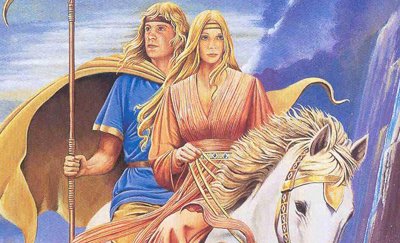In a typical hero's journey, the protagonist sets out on an adventure, undergoes great change, and returns in triumph to their point of origin. But in the Irish genre of myth known as Eachtrai, the journey to the other world ends in a point of no return.


While there are many different versions of the otherworld in Irish mythology, the most well-known example occurs in the story of Oisin.
.
Oisin was the son of Fionn mac Cumhall, the leader of a group of pagan warriors known as the Fianna. As Oisin rode with his companions one day, he was visited by the immortal princess Niamh. The two fell instantly in love and Niamh put Oisin onto her white horse and rode with him to the edge of the Irish sea. As they made for the horizon, the riders sunk into a golden haze. They came to the shores of the gleaming kingdom called Tír na nÓg. This was the home of the Tuatha Dé Danann, the people who ruled Ancient Ireland long before Oisin's time.
From the point of his arrival, Oisin's every need was met. He married Niamh in a grand ceremony and was welcomed into her family. When he wished to hear music, his ears filled with bewitching tones. When he hungered, golden plates appeared laden with fragrant food. He admired scenes of great beauty, and colors that he had no name for. All around him, the land and the people existed in a state of unmoving perfection. But what Oisin didn't know was that Tír na nÓg was the land of youth, in which time stood still and the people never aged. In his new home, Oisin continued to hunt and explore as he had in Ireland. But in the land of youth, he possessed a strange, new invincibility. At the end of each day of adventuring, Oisin's wounds magically healed themselves as he slept in Niamh's arms.
Although glory and pleasure came easily to Oisin in the land of youth, he missed the Fianna and the adventures they had in Ireland. After three years in Tír na nÓg, he was struck by a deep yearning for home. Before he embarked on his journey back, Niamh warned him that he must not alight from his horse to touch the earth with his own feet. When Oisin reached the shores of Ireland, it felt as if a shadow had fallen over the world. On the hill where his father's palace lay, he saw only a ruin strewn with weeds.
His calls for his friends and family echoed from derelict walls. Horrified, Oisin rode until he came upon a group of peasants working in the fields. They were struggling to remove a boulder from their land, and forgetting Niamh's warning, Oisin leapt from his horse and rolled it away with his superhuman strength. The crowd's cheers soon turned into shrieks. In place of the youth was an old man whose beard swept the ground and whose legs buckled under him. He cried out for Finn and the Fianna, but the people only recognized these names from the distant past of 300 years before.
Time had betrayed Oisin and his return to mortal lands had aged him irreversibly. Throughout Irish folklore, sightings of the land of youth have been reported in the depths of wells, on the brink of the horizon, or in the gloom of caves. But those who know the tale of Oisin tell of another vision, that of a shining princess carried upon the distant waves by a white horse, still hoping for the return of her doomed love.
